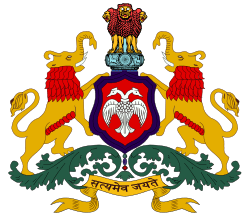History of Kodagu
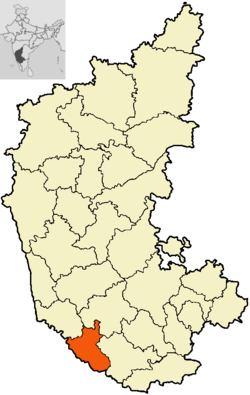
The district of Kodagu in present-day Karnataka comprises the area of the former princely state of the same name.
Early history

_-_Copy.jpg)
Kannada inscriptions speak of Kudagu nad (parts of Kodagu, Western Mysore and Kerala) as well. Both the name of the natives and of the region are synonymous (Kodava-Kodavu; Kodaga-Kodagu; Coorgs-Coorg).[2]
The Haleri dynasty
Early Haleri
The Haleri dynasty was an offshoot of Keladi Nayakas also called Ikkeri Arasu dynasty. Kodagu was independent of Mysore, which was hard pressed by enemies, and a prince of the Ikkeri or Bednur family (perhaps related to the Changalvas) succeeded in bringing the whole country under his sway, his descendants continuing to be Rajas of Kodagu till 1834. The capital was removed in 1681 by Muddu Raja to Madikeri (Mercara).
Mysore Sultan
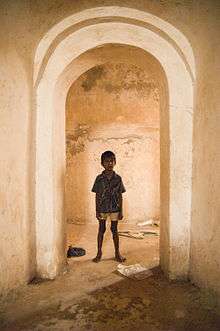
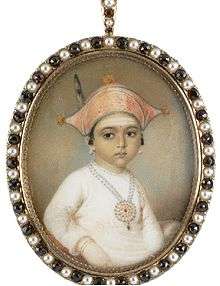
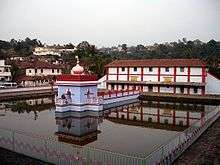
In 1770 a disputed succession led to the intervention of Hyder Ali of Mysore in favour of Linga Raja, who had fled to him for justice, and whom he placed on the throne benevolently. As a gesture of his gratitude, the Raja ceded certain territories and offered to pay tribute. On Linga Rajas death in 1780 Hyder Ali interned his sons, who were minors, in a fort in Mysore, and installed a governor as their guardian at Mercara with a Mysore garrison. In 1782, however, the Kodava rose in rebellion and drove out the Mysore troops. Two years later Tipu Sultan incited the Kodavas and to become violent by means of a derogatory speech made in Madikeri. In that speech, he spoke about an instance of five brothers having a wife in common among the Hindus (a reference to the Pandavas). He 'punished' the Kodavas, for having again rebelled in 1785, by capturing them in large numbers by treachery over a peace deal, imprisoning them and converting them. Those who refused were killed and the land was reduced and held down by garrisons in four forts. In 1788, however, Dodda Vira Raja (or Vira Rajendra Wodeyar), with his wife and his brothers Linga Raja and Appaji, succeeded in escaping from his captivity, at Periapatam and, placing himself at the head of a Kodava rebellion, aligned with the British and succeeded in driving the forces of Tipu (who had aligned with the French) out of the country. On the spot where he had first met the British commander, General Abercromby, the Kodagu Raja founded the city of Virarajendrapet (this is now usually called Virajpet). Those who were converted to Islam by Tipu were settled in Kodagu in their respective villages. Parts of Northern Kodagu had been depopulated as Tipu's men had killed the Kodava farmers of those regions. So the Raja got Tulu and Kannada farmers (later called Kodagu Are'bhashe Gowdas) from neighbouring Sulya (which was part of coorg'called lower coorg')(Dakshina Kannada) and Sakleshpura (Hassan) to settle down in those regions. Meanwhile, craftsmen and farmers from Northern Kerala, called Airi and Heggade, were also settled in parts of Kodagu at that time. Konkani Roman Catholics who escaped imprisonment in Srirangapatna (Mysore's capital at that time) were settled down in Virajpet town. While some 50,000 Kodavas were reported missing (most of them were killed in the Mysore Sultanate atrocities and a remaining minuscule few were converted into Mappilas), some 10,000-15,000 Kodavas still existed in Kodagu at that time. The total population of Kodagu was very small at that time (around 25,00-50,000) as a result of the mass killings and ethnic cleansing under the Mysore Sultan.
Later Haleri

Dodda Vira Raja, who, in consequence of his mind becoming unhinged, was guilty towards the end of his reign of hideous atrocities, died in 1809 without male heirs, leaving his favourite daughter Devammji as Rani. His brother Linga Raja, however, after acting as regent for his niece, announced in 1811, his own assumption of the government. He died in 1820 and was succeeded by his son Chikka Vira Raja, a youth of twenty, and a monster of sensuality and cruelty. Among his victims were all the members of the families of his predecessors, including Devammaji. The last few Rajas and their family members married members of the Mukkatira and Palanganda Kodava families. At last, in 1832, evidence of treasonable designs on the Raja's part led to inquiries on the spot by the British resident at Mysore, as the result of which, and of the Raja's refusal to amend his ways, a British force marched into Kodagu in 1834 after a medium-sized war when the Raja surrendered. It was a short but bloody campaign that occurred in which a number of British men and officers were killed. Near Somwarpet, where the Coorgs were led by Mathanda Appachu the resistance had been most furious. But this Coorg campaign came to a quick end when the Raja himself cowardly surrendered to the British.[2][3][4]
British rule


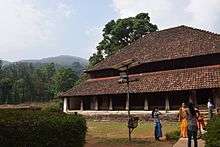
On 11 April 1834, the raja was deposed by Colonel Fraser, the political agent with the force, and on 7 May the state was formally annexed to the East India Company's territory, as Coorg. In 1852 the Raja, who had been deported to Vellore, obtained leave to visit England with his favourite daughter Gauramma, to whom he wished to give a European education. On 30 June she was baptized, Queen Victoria being one of her sponsors; she afterwards married a British officer who, after her death in 1864, mysteriously disappeared together with their child. Vira Raja himself died in 1863 and was buried in Kensal Green cemetery.
The Coorg rebellion of 1837 is said to be a rising of the Tulu/Arebashe Gowdas of Amara Sulya (in Dakshina Kannada, Greater Kodagu) due to the grievance felt in having to pay taxes in money instead of in kind. A man named Virappa, who pretended to have escaped from the massacre of 1820, tried to take advantage of this to assert his claim to be Raja, but the people remained loyal to the British, as they knew that this was a hoax and so the attempt failed. However, a few of the people of Kodagu, from Nalknad and Yedavanad, supported the rebels. They were led by Subedar Guddemane Appaiah Gowda, Subedar Mandira Uthaiah, Shanthalli Mallaiah and Chetty Kudiya. (In neighbouring Dakshina Kannada they were led by Kedambadi Rama Gowda, Beeranna Bunta and others.)[5]
Coorg (Kodagu) was the smallest province in India, its area is only 1582 square miles (4,100 km²). As a province of British India, it was administered by a commissioner, subordinate to the Governor-General of India through the resident of Mysore, who was also officially chief commissioner of Coorg. Later freedom fighters from Kodagu supported the National Independence Movement. One of them, Pandyanda Belliappa was known as Kodagu's Gandhi.[6][2]
Independent India
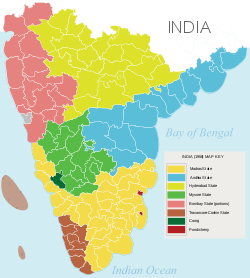
After India's independence in 1947, Coorg became a province, and in 1950 a state by name of Coorg State of Republic of India. In 1952 elections to the Coorg Legislative Assembly were held.In 1956, when India's state boundaries were reorganized along linguistic lines, it became a district of the then Mysore state.
The Chief commissioners of Coorg were;
- 1947 - 1949 Dewan Bahadur Ketolira Chengappa
- 1949 - 1950 C.T. Mudaliar
- 1950 - 1956 Kanwar Daya Singh Bedi
The Chief minister 1952-1956 was C.M. Poonacha.[7]
Mysore state later became the modern state of Karnataka, and the formal name of the district returned to the original, Kodagu.[8]
Many Coorgs joined the Indian army, the Indian hockey team and other sports. Prominent among them were Field Marshal Cariappa, General Thimmaiah, Lt. Gen. Iyappa (BEL chairman Aiyappa), Sqdn Leader Ajjamada Devaiah (war martyr), hockey captain M P Ganesh, tennis player Rohan Bopanna, CAG C G Somiah, etc., Kodagu district#Notable people from Kodagu
See also
References
- ↑ "Portico of the Coorg Rajah's Palace at Somwaspett". The Wesleyan Juvenile Offering: A Miscellany of Missionary Information for Young Persons. Wesleyan Missionary Society. X: 48. May 1853. Retrieved 29 February 2016.
- 1 2 3 Kamath, Dr. S. U. (1993). Karnataka State Gazetteer: Kodagu District. Bangalore: Government Press. p. 160.
- ↑ Muthanna, I. M. (1953). A Tiny Model State of South India. Kodagu: Tiny Spot. p. 99.
- ↑ Ponnappa, Lt. Col. K. C. (1999). A Study of the Origins of Coorgs. Kodagu: Kodagu. p. 23.
- ↑ Correspondent, Staff. "Appaiah Gowda's feats to be remembered". The Hindu. Retrieved 23 October 2013.
- ↑ Correspondent, C M Ramachandra. "Coorg and the Reorganisation of States". The Hindu. Retrieved 15 August 2017.
- ↑ http://rulers.org/indstat3.html
- ↑ "Coorg (district, India)". Britannica Online Encyclopedia. Retrieved 2012-06-01.
